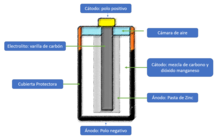Cathode
A cathode, from a chemical point of view, is the role an electrode plays when it undergoes a reduction reaction, through which a material reduces its oxidation state by receiving electrons.
| A | Galvanic skin | Electrolytic cell |
|---|---|---|
| Type of transformation | Chemical energy → Electric energy | Electrical energy → Chemical energy |
| Positive electrode | Method (reduction) | Anode (oxidation) |
| Negative electrode | Anode (oxidation) | Method (reduction) |
|
From the point of view of electronics and similar to how a battery works, some electronic components have predefined directions of flow of electric current such as a diode or a cathode ray tube. In this case, we will define the cathode as that end of the component through which the electrical current must exit (through which the electrons enter).
The polarity of the cathode, positive or negative, depends on the type of device. Sometimes it is conditioned by the mode of operation, since it is established according to the direction of the electric current, according to the universal definition of electric current. Consequently, in a device that consumes power (such as an electrolytic cell) the cathode is negative, and in a device that provides power, such as a voltaic cell (or Volta cell or battery) the cathode is positive.
Etymology
The term was acquired by Faraday (series VII of the Experimental Investigations on Electricity), with the meaning of «descending path» or «exit path», since it comes from the Greek κατά [catá]: 'downwards', and ὁδός [odós]: 'path', but referring exclusively to the electrolyte of an electrochemical cell.
Conventionality of senses
Its connection to the negative pole of the corresponding generator implies the assumption that the electric current circulates through the external circuit from the positive to the negative pole; that is, it is carried by positive charges, which is the usual convention. If the external conductor is metallic, the direction of the current is really the path of the electrons towards the positive pole.
However, in an electrolytic cell, the conductor is the electrolyte, not a metal. Negative and positive ions can coexist in it, which when moving take opposite directions. By convention, it is assumed that the direction of the current is from the anode to the cathode or, what is the same, from the positive to the negative pole.
In the case of thermoionic valves, diodes, thyristors, electrical sources, batteries, etc., the cathode is the electrode or terminal with the highest potential. Therefore, in a redox reaction it corresponds to the element that is reduced.
Thermionic cathode
It is an electrode that, due to the effect of heat, emits electrons (thermionic effect). In these devices (thermionic valves) it is connected to the negative voltage and is the source of electrons. The cathode can be heated by itself, by making a heating current circulate through it, or by means of a filament to which it is thermally coupled.
To prolong the efficient duration of thermionic devices, materials are used that at low temperatures provide great emission of electrons. For this reason, alloys of thorium, tungsten (also known as tungsten) and lanthanides are used, or the cathode is coated with calcium oxide.
Contenido relacionado
Tellurium
Lipid bilayer
Annex: periodic table

